axial-bonding type tin(IV) tetratolylporphyrin based hybrid porphyrin arrays
- 格式:pdf
- 大小:457.60 KB
- 文档页数:12
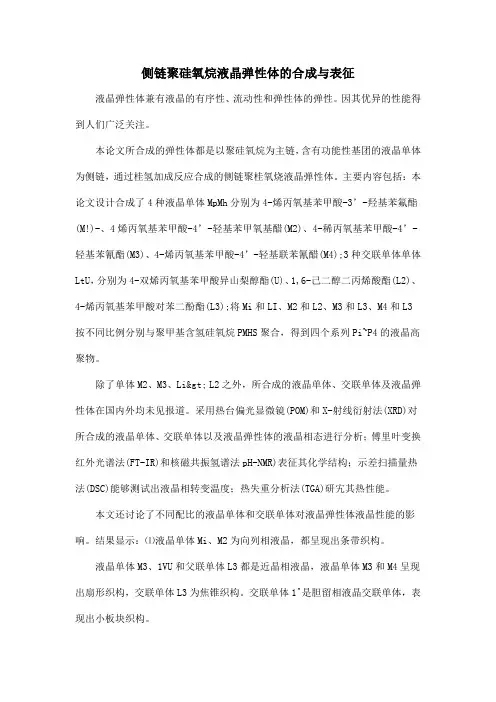
侧链聚硅氧烷液晶弹性体的合成与表征液晶弹性体兼有液晶的有序性、流动性和弹性体的弹性。
因其优异的性能得到人们广泛关注。
本论文所合成的弹性体都是以聚硅氧烷为主链,含有功能性基团的液晶单体为侧链,通过桂氢加成反应合成的侧链聚桂氧烧液晶弹性体。
主要内容包括:本论文设计合成了4种液晶单体MpMh分别为4-烯丙氧基苯甲酸-3’-羟基苯氟酯(M!)-、4烯丙氧基苯甲酸-4’-轻基苯甲氧基醋(M2)、4-稀丙氧基苯甲酸-4’-轻基苯氰酯(M3)、4-烯丙氧基苯甲酸-4’-轻基联苯氰醋(M4);3种交联单体单体LtU,分别为4-双烯丙氧基苯甲酸异山梨醇酯(U)、1,6-己二醇二丙烯酸酯(L2)、4-烯丙氧基苯甲酸对苯二酚酯(L3);将Mi和LI、M2和L2、M3和L3、M4和L3按不同比例分别与聚甲基含氢硅氧烷PMHS聚合,得到四个系列Pi~P4的液晶高聚物。
除了单体M2、M3、Li> L2之外,所合成的液晶单体、交联单体及液晶弹性体在国内外均未见报道。
采用热台偏光显微镜(POM)和X-射线衍射法(XRD)对所合成的液晶单体、交联单体以及液晶弹性体的液晶相态进行分析;傅里叶变换红外光谱法(FT-IR)和核磁共振氢谱法pH-NMR)表征其化学结构;示差扫描量热法(DSC)能够测试出液晶相转变温度;热失重分析法(TGA)研宄其热性能。
本文还讨论了不同配比的液晶单体和交联单体对液晶弹性体液晶性能的影响。
结果显示:⑴液晶单体Mi、M2为向列相液晶,都呈现出条带织构。
液晶单体M3、1VU和父联单体L3都是近晶相液晶,液晶单体M3和M4呈现出扇形织构,交联单体L3为焦锥织构。
交联单体1^是胆留相液晶交联单体,表现出小板块织构。
弹性体PtP#系列除P2-6之外都具有液晶性。
弹性体Pi、P3和P4系列都为近晶相液晶。
弹性体P2-l~P2-5表现出向列相条带织构。
(2)热性能上,液晶单体Mi~M4和液晶交联单体Li、L3的Td(5wt%)都大于180°C,有良好的热稳定性。
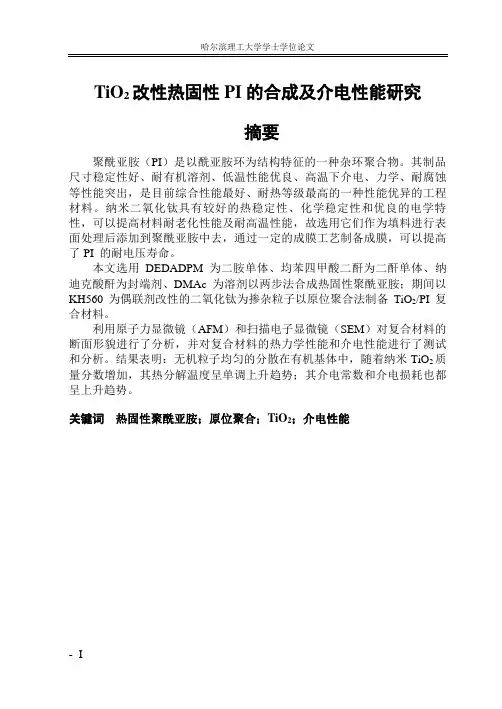
TiO2改性热固性PI的合成及介电性能研究摘要聚酰亚胺(PI)是以酰亚胺环为结构特征的一种杂环聚合物。
其制品尺寸稳定性好、耐有机溶剂、低温性能优良、高温下介电、力学、耐腐蚀等性能突出,是目前综合性能最好、耐热等级最高的一种性能优异的工程材料。
纳米二氧化钛具有较好的热稳定性、化学稳定性和优良的电学特性,可以提高材料耐老化性能及耐高温性能,故选用它们作为填料进行表面处理后添加到聚酰亚胺中去,通过一定的成膜工艺制备成膜,可以提高了PI 的耐电压寿命。
本文选用DEDADPM为二胺单体、均苯四甲酸二酐为二酐单体、纳迪克酸酐为封端剂、DMAc为溶剂以两步法合成热固性聚酰亚胺;期间以KH560为偶联剂改性的二氧化钛为掺杂粒子以原位聚合法制备TiO2/PI复合材料。
利用原子力显微镜(AFM)和扫描电子显微镜(SEM)对复合材料的断面形貌进行了分析,并对复合材料的热力学性能和介电性能进行了测试和分析。
结果表明:无机粒子均匀的分散在有机基体中,随着纳米TiO2质量分数增加,其热分解温度呈单调上升趋势;其介电常数和介电损耗也都呈上升趋势。
关键词热固性聚酰亚胺;原位聚合;TiO2;介电性能Synthesis and Study on dielectric properties ofthermosetting polyimide modified by TiO2AbstractPolyimide (PI) is defined as a kind of heterocyclic polymers with imide ring structure. Its products own good dimensional stability, resistance to organic solvents, well performance at low temperature, high temperature dielectric, mechanical, corrosion and other outstanding performance, which currently give the best overall performance and the highest level of integrated heat resistivity that known as engineering materials. Nanostructured titanium dioxide has better thermal stability, chemical stability and excellent electrical properties, not only improve the properties of aging resistance and high temperature resistivity, but also thermal expansion coefficient in accordance with polyimide match, so are used as fillers with previous surface modification, then added to the polyimide. Further more, some films are prepared by film-forming process with polyimide, which increase the voltage resistance life of PI.In this article, thermosetting polyimide is prepared via two steps in the presence of DEDADPM as monomer, pyromellitic dianhydride as dianhydride monomer, Nadi Ke anhydride as capping agent, DMAC as the solvent; during the course, nanostructured titanium dioxide which functions as doping particles are modified by the Silone coupling agent of KH-550, then used to polymerize TiO2/PI composites.Atomic force microscopy (AFM) and scanning electron microscopy (SEM) are used to analyze fracture morphology of the composite, and tests related to thermodynamic and dielectric properties of composite materials are also conducted. The results showed that: inorganic particles evenly dispersed in organic matrix, not only increasement of thermal decomposition temperature accompanies by the increase of mass fraction of nano-TiO2, but also thedielectric constant and dielectric loss experiences above trends.Key words Thermosetting polyimide; In situ polymerization;Titanium dioxide; Dielectric properties目录摘要.................................................................................. 错误!未找到引用源。
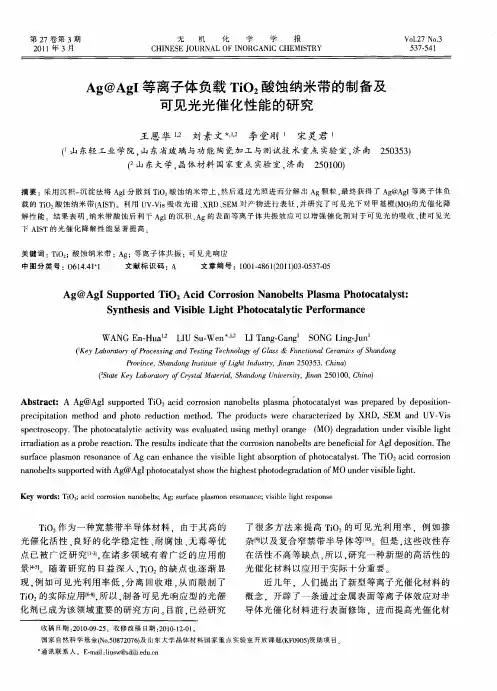
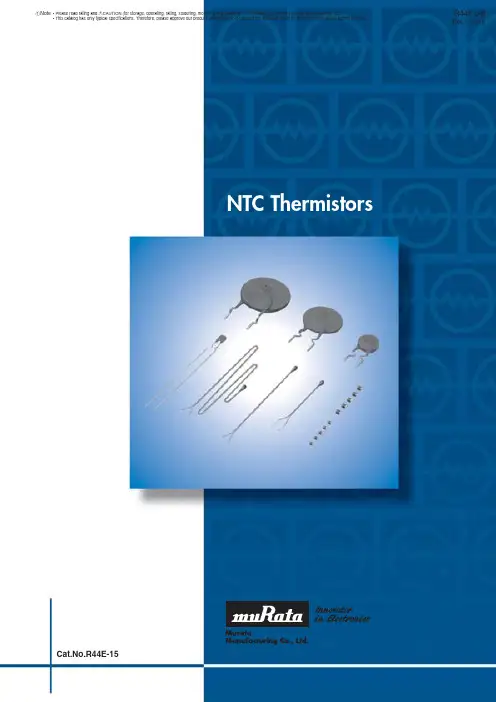
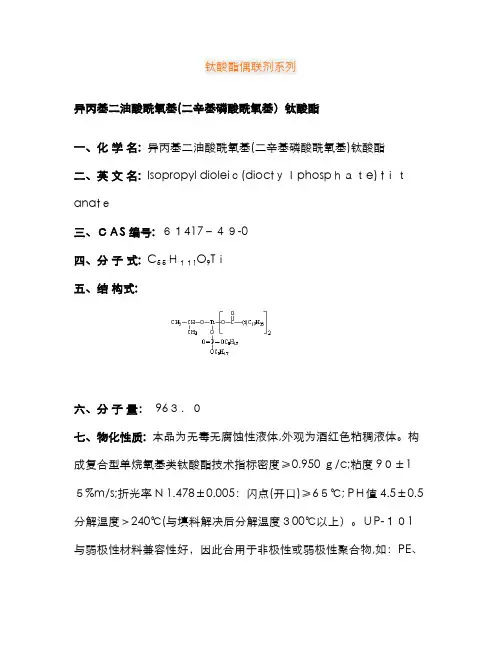
钛酸酯偶联剂系列异丙基二油酸酰氧基(二辛基磷酸酰氧基)钛酸酯一、化学名: 异丙基二油酸酰氧基(二辛基磷酸酰氧基)钛酸酯二、英文名: Isopropyl dioleic(dioctylphosphate) titanate三、CAS 编号: 61417-49-0四、分子式: C55H111O9Ti五、结构式:六、分子量:963.0七、物化性质: 本品为无毒无腐蚀性液体,外观为酒红色粘稠液体。
构成复合型单烷氧基类钛酸酯技术指标密度≥0.950 g/c;粘度90±15%m/s;折光率N 1.478±0.005:闪点(开口)≥65℃; PH值4.5±0.5分解温度>240℃(与填料解决后分解温度300℃以上)。
UP-101与弱极性材料兼容性好,因此合用于非极性或弱极性聚合物,如:PE、PP等,以提高复合材料旳机械强度及其他性能。
可溶于有机溶剂(如:异丙醇、二甲苯、甲苯、DOP、矿物油),遇水水解。
八、用途: 本品重要用于解决碳酸钙、滑石粉等无机填料,改善无机填料与树脂旳兼容性,从而改善非极性或弱极性聚合物,如:PE、PP 等复合材料制品旳机械性能、加工性能,可提高复合材料旳热稳定性,实现高填充。
用本品解决过旳无机填料用于涂料中,可减少体系粘度、提高无机填料填充量。
用于磁记录材料和橡塑磁性材料,磁粉经它解决后,可改善其在基材上旳分散以及对聚合物旳粘合,使磁记录材料有较好旳流动性、可涂性、高剪切强度、不易脱落,且韧性好。
九、注意事项: 填料预解决后,若出料寄存,应注意散热(搅拌热)以免填料受热性能下降。
本品非螯合型,不可与水接触,否则失效。
但填料中游离水份无影响。
十、包装:25KG或200KG塑料桶装。
十一、贮存: 密封储存于阴凉、干燥通风处,避光、隔热。
异丙基三(二辛基磷酸酰氧基)钛酸酯英文名: Isopropyltri(dioctylphosphate) titanateCAS编号: 65345-34-8分子式:C51H109O13P3Ti结构式:分子量:1070.0物化性质: 本品为米黄色粘稠液体,密度(ρ20℃)1.01g/㎝3,可溶于异丙醇、苯、甲苯、二甲苯等有机溶剂,易水解,与增塑剂DOP反映,分解温度260℃。
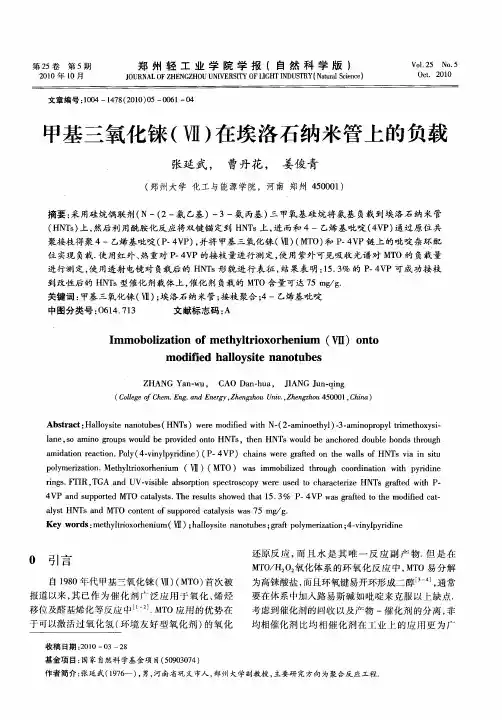
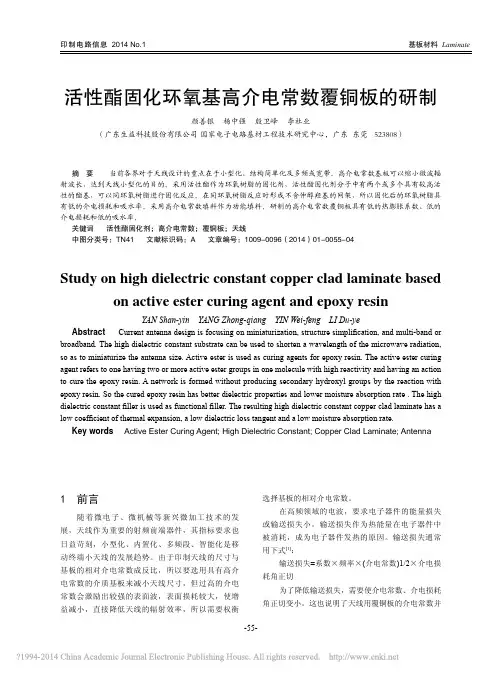
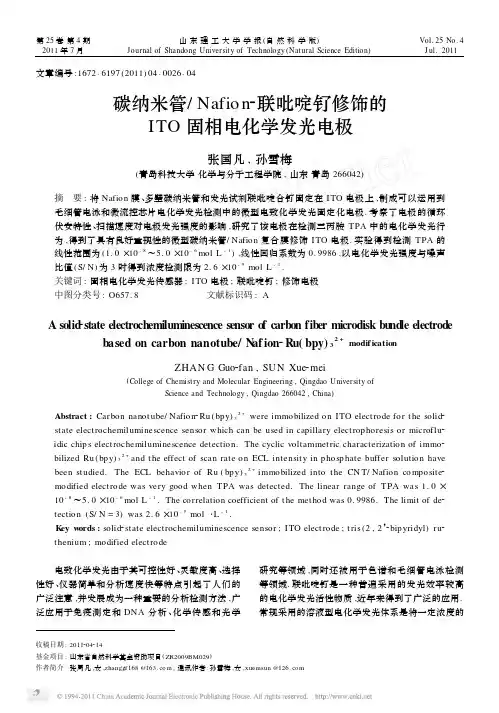
第25卷第4期2011年7月山东理工大学学报(自然科学版)Journal of Shandong University of Technology (Natural Science Edition )Vol.25No.4J ul.2011收稿日期:2011204214基金项目:山东省自然科学基金资助项目(ZR2009BM029)作者简介:张周凡,女,zhanggf168@ ;通讯作者:孙雪梅,女,xuemsun @文章编号:1672-6197(2011)04-0026-04碳纳米管/Nafio n 2联吡啶钌修饰的ITO 固相电化学发光电极张国凡,孙雪梅(青岛科技大学化学与分子工程学院,山东青岛266042)摘 要:将Nafio n 膜、多壁碳纳米管和发光试剂联吡啶合钌固定在ITO 电极上,制成可以运用到毛细管电泳和微流控芯片电化学发光检测中的微型电致化学发光固定化电极.考察了电极的循环伏安特性、扫描速度对电极发光强度的影响,研究了该电极在检测三丙胺TPA 中的电化学发光行为,得到了具有良好重现性的微型碳纳米管/Nafion 复合膜修饰ITO 电极.实验得到检测TPA 的线性范围为(1.0×10-8~5.0×10-6mol .L -1),线性回归系数为0.9986,以电化学发光强度与噪声比值(S/N )为3时得到浓度检测限为2.6×10-9mol .L -1.关键词:固相电化学发光传感器;ITO 电极;联吡啶钌;修饰电极中图分类号:O657.8文献标识码:AA solid 2state electroch emiluminescence sensor o f carbon fib er microdisk bu nd le electrod ebased on carbon nanotube/N af ion 2Ru(bpy)32+modif icationZHAN G Guo 2fan ,SUN Xue 2mei(College of Chemistry and Molecular Engineering ,Qingdao University ofScience and Technology ,Qingdao 266042,China )Abstract :Carbon nanot ube/Nafion 2Ru (bpy )32+were immobilized on ITO elect rode for t he solid 2state electrochemiluminescence sensor which can be used in capillary elect rop horesis or microflu 2idic chip s elect rochemiluminescence detection.The cyclic voltammet ric characterization of immo 2bilized Ru (bpy )32+and t he effect of scan rate on ECL intensity in p ho sp hate buffer solution have been st udied.The ECL behavior of Ru (bpy )32+immo bilized into t he CN T/Nafion composite 2modified elect rode was very good when TPA was detected.The linear range of TPA was 1.0×10-8~5.0×10-6mol L -1.The correlation coefficient of t he met hod was 0.9986.The limit of de 2tection (S/N =3)was 2.6×10-9mol ・L -1.K ey w ords :solid 2state electrochemiluminescence sensor ;ITO elect rode ;t ris (2,2’2bipyridyl )ru 2t henium ;modified electrode 电致化学发光由于其可控性好、灵敏度高、选择性好、仪器简单和分析速度快等特点引起了人们的广泛注意,并发展成为一种重要的分析检测方法,广泛应用于免疫测定和DNA 分析、化学传感和光学研究等领域,同时还被用于色谱和毛细管电泳检测等领域.联吡啶钌是一种普遍采用的发光效率较高的电化学发光活性物质,近年来得到了广泛的应用.常规采用的溶液型电化学发光体系是将一定浓度的联吡啶钌加入到缓冲液中,这种方式会由于试剂的不断消耗带来很多问题,如发光试剂消耗多、运行成本高以及环境污染.在电化学发光反应中可以把发光试剂联吡啶钌固定在工作电极表面,这样制成的电化学发光电极既保留了电化学发光的优点,又可以使联吡啶钌在电极表面得到循环使用.这可以克服溶液型电化学发光试剂在电化学发光分析中存在的问题,拓宽电化学发光分析法的应用面,实现仪器的小型化和增加方法的实用性.1980年Rubinstein和Bard[1]首先报道了Nation膜包埋Ru(bpy)32+修饰电极ECL.目前将联吡啶钌固定在电极上的方法有很多,如溶胶2凝胶法[225],Nafion膜法[628],L2B(Langmuir2 Blodgett)膜法[9210]和自组装(SA)膜法[11213].我们在研究中发现,文献中所报道的将发光试剂Ru(bpy)32+固定在电极上的电化学发光传感器尺寸往往都比较大,无法将其运用到我们现在所采用的毛细管电泳和微流控芯片的电化学发光检测上,因此我们希望能够制备电极尺寸与毛细管内径或微流控芯片出口通道内径相近的微型电化学发光固定化电极,以便在毛细管电泳和微流控芯片上使用.1 实验部分1.1 实验仪器、材料与试剂M PI2A型毛细管电泳电化学发光检测仪(西安瑞迈分析仪器有限公司,西安);离心机(TDL2 40B,上海安亭科学仪器厂);超声波清洗器(KQ2 500B,昆山市超声仪器有限公司,昆山,江苏);三电极体系采用自制ITO电极(深圳南玻伟光导电膜有限公司,广东)为工作电极,铂丝电极为辅助电极,饱和甘汞电极为参比电极.K3[Fe(CN)6](天津市瑞金特化学品有限公司,AR);Na H2PO4・2H2O(上海亨达精细化工有限公司,上海);Na2H PO4・12H2O(天津市博迪化工有限公司,天津);联吡啶钌(Ru(bpy)32+,Sigma 公司).多壁碳纳米管(Multiwalled carbon nano2 t ubes,MWCN Ts,纯度>95%,内径10~20nm,长度~30um,深圳纳米港有限公司,广东).Nafion 试剂(Aldrich公司,美国)1.2 实验方法1.2.1 ITO电极的处理用玻璃刀将整块ITO电极切割成2.00cm×1.00cm大小,用丙酮溶液、二次水分别超声清洗15 min,然后在饱和NaO H溶液中浸泡30min,电极使用前用二次水超声清洗5min,用镜头纸擦干备用.1.2.2 CN T/Nafion复合膜修饰ITO电极的制备取0.2mg MWCN T超声分散在0.4mL0.5 wt%的Nafion溶液中,得到0.5mg・mL-1的碳纳米管悬浮液.在ITO电极上滴加 5.00μL 0.5mg・mL-1的碳纳米管/Nafion悬浮液,室温晾干,再滴加5.00μL 1.00×10-2mol・L-1的Ru (bpy)32+溶液,室温晾干后在2.00×10-2mol・L-1磷酸盐缓冲溶液中进行循环伏安扫描至信号稳定.2 结果与讨论2.1 碳纳米管/Nafion复合膜修饰ITO电极的循环伏安行为 用循环伏安法考察了固定在碳纳米管/Nafion2联吡啶钌修饰电极表面Ru(bpy)32+的电化学行为,如图1所示.图1中曲线1、2、3分别为在p H=7.4的0.02mol・L-1磷酸缓冲溶液中裸的ITO电极(1),碳纳米管/Nafion膜修饰的ITO电极在浸入Ru(bpy)32+溶液之前(2)和浸入Ru(bpy)32+溶液并达到吸附饱和以后(3)的循环伏安曲线.由图1可以看出,曲线1几乎没有电化学响应,而曲线2充电电流增加,这可能是由于碳纳米管的加入使电极表面积增加的原因.在相同条件下的曲线3,在1.25 V左右有一个很大的氧化还原电流峰,这是联吡啶钌典型的氧化还原特征峰.这个结果说明通过简单地将复合物膜修饰的电极浸入联吡啶钌溶液后可以有效地固定联吡啶钌.由于Nafion含有一个由碳氟骨架和离子化的磺酸基团构成的憎水区,所以有阴离子交换能力的Nafion和碳纳米管构成的复合物膜可以很容易通过离子交换过程、憎水作用和静电吸引作用而吸附憎水性阳离子,如联吡啶钌.只需简单地用联吡啶钌溶液浸泡复合物膜修饰电极,联吡啶钌就会被吸附在复合物膜中.2.2 扫描速度对碳纳米管/Nafion复合膜修饰ITO电极的影响 通过考察电极扫描速度对电极电化学发光强度的影响,发现电化学发光对扫描电位曲线的整体形状与扫描速度有较大关系.在p H=7.4的0.02 mol・L-1磷酸缓冲溶液中考察了扫描速度对该碳72第4期 张国凡,等:碳纳米管/Nafion2联吡啶钌修饰的ITO固相电化学发光电极图1 裸的ITO电极(1)和碳纳米管/Nafion膜修饰的ITO电极在浸入Ru(bpy)32+溶液之前(2)浸入Ru(bpy)32+溶液以后(3)在p H=7.4,0.02mol・L-1磷酸盐缓冲溶液中的循环伏安曲线纳米管/Nafion复合膜修饰ITO电极循环伏安行为的影响,所得到的电极电化学发光强度与扫描速度的关系曲线如图2所示.当扫描速度在0.005~0.02V/s范围内时,随着扫描速度的增加电极的电化学发光强度降低,当扫描速度在0.02~0.2V/s范围内时,电化学发光强度相对保持恒定.由于碳纳米管/Nafion复合物膜的开放结构,电化学发光反应中间体的形成会影响相对电化学发光强度随扫描速度的变化.在随后的实验中我们选择的电极扫速为0.1V/s.图2 不同扫速下碳纳米管/Nafion2Ru(bpy)32+修饰电极的ECL强度2.3 碳纳米管/Nafion复合膜修饰ITO电极的电化学发光行为 在此实验中,我们考察了碳纳米管/Nafion复合膜修饰ITO电极的电化学发光行为.在p H=7.4的0.02mol・L-1磷酸缓冲溶液中,在0.5~1.4V 范围内对电极作循环伏安扫描所得到的电化学发光强度对电位曲线如图3所示.由图3可以看出,在电位为1.1V附近开始有发光信号,随后随着电极电位的增加,电极的电化学发光信号急剧增强,在1.25V附近电极的电化学发光强度达到最大,说明在该电极电位下电极上的联吡啶钌被电化学氧化而发生电化学发光反应,从而得到较强的电化学发光信号.图3 在循环伏安扫描时相应的ECL强度-电位曲线2.4 碳纳米管/Nafion复合膜修饰ITO电极对三丙胺的电化学发光行为 图4中曲线1、2分别为扫描速度为0.1V/s 时,固定有联吡啶钌的CN T/Nafion复合膜修饰电极在不含三丙胺和含有1.00×10-7mol・L-1三丙胺的电化学发光曲线.由图4可以看出,三丙胺的加入引起了联吡啶钌电化学发光信号的大大增强,这是由联吡啶钌和三丙胺之间发生电化学发光反应所致.图4 碳纳米管/Nafion复合膜修饰ITO电极在不含(1)和含有(2)1.00×10-7mol.L-1三丙胺的0.02mol.L-1磷酸盐缓冲溶液中在扫速为0.1V/s时的电化学发光图2.5 碳纳米管/Nafion复合膜修饰ITO电极检测三丙胺的线性范围、检测限及电极的重现性 在p H=7.4的0.02mol・L-1磷酸缓冲溶液中,在扫速为0.1V/s时用碳纳米管/Nafion复合物修饰ITO电极测定TPA.配置了一系列不同浓度的TPA标准溶液,测定不同浓度下的电化学发光强度值,以lg c对lg(ECL intensity)作图,示于图5,得到TPA的线性范围为(1.0×10-8~5.0×10-6 mol・L-1),线性回归系数为0.9986,并以电化学发光强度与噪声比值(S/N)为3时得到浓度检测限为82山东理工大学学报(自然科学版)2011年 2.6×10-9mol ・L -1.图5 三丙胺的lgc (mol ・L -1)与ECL intensity (a.u.)的对数关系图对CN T/Nafion 复合膜修饰电极用于电化学发光测定三丙胺时的重现性进行了研究,连续循环电位扫描7圈,在复合物修饰电极上所记录的电化学发光信号示于图6.7次电位扫描对应的电化学发光信号的相对标准偏差小于2.3%,说明CN T/Na 2fion 复合物膜修饰电极用于电化学发光测定TPA 具有很好的重现性.这个结果可能是复合物膜中电荷传递比较快和复合物膜比较稳定的原因.图6 碳纳米管/Nafion 复合膜修饰ITO 在1.00×10-7mol ・L -1三丙胺溶液中连续循环扫描7圈的ECL 信号3 结束语碳纳米管/Nafion 复合膜是一种有效、稳定地固定联吡啶钌的新材料,本文利用碳纳米管/Na 2fion 复合膜将钌有效固定在ITO 电极上,制成了微型的电化学发光固定化电极.由于碳纳米管有较大的表面积和电催化作用,固定化的联吡啶钌的氧化还原电流大大增加,电化学发光信号也有很大的增强,且具有良好的稳定性.综合考虑这种电化学发光传感器的稳定性及响应时间快、易于制备和基质的生物相容性好等优点,此体系在毛细管电泳和微流控芯片电化学发光检测方面具有潜在的应用前景.参考文献:[1]Rubinstein I ,Bard A J.Polymer 2films on electrodes.4.Nation 2coated electrodes and electrogenerated chemiuminescence of sur 2face 2attached tris (2,2’2bipyridine )rut henium (2+)[J ].J.Am.Chem.Soc.,1980,102:664126642[2]Wang H Y ,Xu G B ,Dong S J.Electrochemiluminescence sen 2sor using tris (2,2’2bipyridyl )rut henium (Ⅱ)immobilized in East man 2AQ55D 2silica composite t hin 2films [J ].Anal.Chim.Acta.,2003,480:2852290.[3]Zhu L D ,Li Y X ,Zhu G Y.A novel flow t hrough optical fiberbiosensor for glucose base on luminal electrochemiluminescence [J ].Sensors and Actuators B ,2002,86:2092214.[4]Yun W ,Xu Y ,Dong P.et al ,Solid 2state electrochemilumines 2cence sensor t hrough t he electrodeposition of Ru (bpy )32+/AuN Ps/chitosan composite film onto electrode [J ].Analytica Chimica Acta ,2009,635:58262.[5]Choi H N ,Cho S H ,Lee W Y.Electrogenerated chemilumines 2cence from tris (2,2’2bipyridyl )rut henium (Ⅱ)immobilized in Titania 2perfluorosulfonated lonomer composite films[J ].Anal.Chem.,2003,75(16):425024256.[6]郭志慧,唐隆健,章竹君,碳纳米管/Nafion 2吡啶钌修饰电极电化学发光法测定激动素[J ].分析化学研究报告,2009,37(1):13218.[7]Guo Z ,Dong S.Elect rogenerated chemiluminescence from Ru(bpy )32+ion 2exchanged in carbon Nanotube/Perfluoorsulfonat 2ed ionomer composite films [J ].Anal.Chem ,2004,76:268322688.[8]Zhang L B ,Li J ,Xu Y H ,et al .Solid 2state electrochemilumi 2nescence sensor based on t he Nafion/poly (sodium 42styrene sul 2fonate )composite film [J ].Talanta ,2009,79:4542459.[9]Miller C J ,McCord P ,Bard A J.Study of Langmuir monolayersof rut henium complexes and t heir aggregation by electrogenerat 2ed chemiluminescence [J ].Langmuir ,1991,7:278122787.[10]Blodgett K B ,Langmuir I ,Built 2up films of barium stearateand t heir optical properties [J ].Phys.Rev ,1937,51:9642982.[11]Denany L ,Forster R J ,Rusling J F.Simultaneous direct elec 2trochemiluminescence and catalytic voltammetry detection of DNA in ultrat hin films [J ].J.Am.Chem.Soc ,2003,125:521325218.[12]Bi L H ,Wang H Y ,Shen Y ,et al .Multifunctional ograinc 2in 2ogranic multilayer films of tris (2,2’2bipyrldine )rut henium and decatungstate [J ]m ,2003,5:9132918.[13]Sun C Y ,Lu W ,Gao Y F.Electrochemiluminescence from Ru(bpy )32+immobilized in poly (3,42et hylenedioxyt hiophene )/poly (styrenesulfonate )poly (vinyl alcohol )composite films [J ].An 2alytica Chimica Acta ,2009,632:632167.(编辑:姚佳良)92第4期 张国凡,等:碳纳米管/Nafion 2联吡啶钌修饰的ITO 固相电化学发光电极。
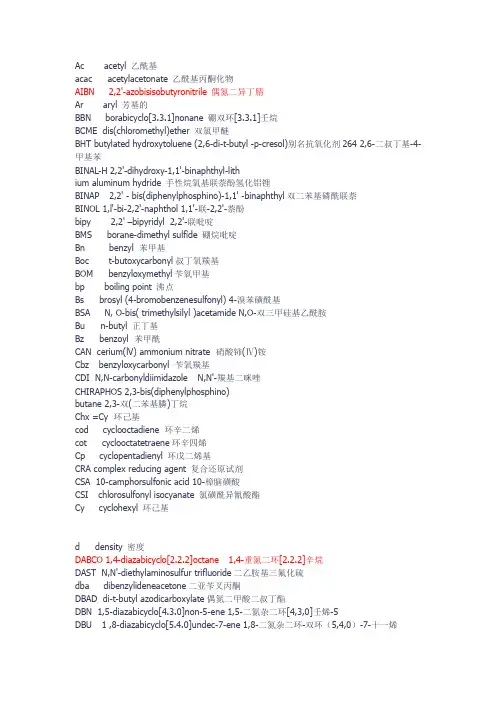
Ac acetyl 乙酰基acac acetylacetonate 乙酰基丙酮化物AIBN 2,2'-azobisisobutyronitrile 偶氮二异丁腈Ar aryl 芳基的BBN borabicyclo[3.3.1]nonane 硼双环[3.3.1]壬烷BCME dis(chloromethyl)ether 双氯甲醚BHT butylated hydroxytoluene (2,6-di-t-butyl -p-cresol)别名抗氧化剂264 2,6-二叔丁基-4-甲基苯BINAL-H 2,2'-dihydroxy-1,1'-binaphthyl-lithium aluminum hydride 手性烷氧基联萘酚氢化铝锂BINAP 2,2' - bis(diphenylphosphino)-1,1' -binaphthyl双二苯基磷酰联萘BINOL 1,l'-bi-2,2'-naphthol 1,1'-联-2,2'-萘酚bipy 2,2' –bipyridyl 2,2'-联吡啶BMS borane-dimethyl sulfìde 硼烷吡啶Bn benzyl 苯甲基Boc t-butoxycarbonyl叔丁氧羰基BOM benzyloxymethyl苄氧甲基bp boiling point 沸点Bs brosyl (4-bromobenzenesulfonyl) 4-溴苯磺酰基BSA N, O-bis( trimethylsilyl )acetamide N,O-双三甲硅基乙酰胺Bu n-butyl 正丁基Bz benzoyl 苯甲酰CAN cerium(lV) ammonium nitrate 硝酸铈(Ⅳ)铵Cbz benzyloxycarbonyl 苄氧羰基CDI N,N-carbonyldiimidazole N,N'-羰基二咪唑CHIRAPHOS 2,3-bis(diphenylphosphino)butane 2,3-双(二苯基膦)丁烷Chx =Cy 环己基cod cyclooctadiene 环辛二烯cot cyclooctatetraene环辛四烯Cp cyclopentadienyl 环戊二烯基CRA complex reducing agent 复合还原试剂CSA 10-camphorsulfonic acid 10-樟脑磺酸CSI chlorosulfonyl isocyanate 氯磺酰异氰酸酯Cy cyclohexyl 环己基d density 密度DABCO 1,4-diazabicyclo[2.2.2]octane 1,4-重氮二环[2.2.2]辛烷DAST N,N'-diethylaminosulfur trifluoride二乙胺基三氟化硫dba dibenzylideneacetone二亚苄叉丙酮DBAD di-t-butyl azodicarboxylate偶氮二甲酸二叔丁酯DBN 1,5-diazabicyclo[4.3.0]non-5-ene 1,5-二氮杂二环[4,3,0]壬烯-5DBU 1 ,8-diazabicyclo[5.4.0]undec-7-ene 1,8-二氮杂二环-双环(5,4,0)-7-十一烯DCC N,N-dicyclohexylcarbodiimide N,N'二环己基碳二亚胺DCME dichloromethyl methyl ether二氯甲基甲醚DDO dimethyldioxirane双十二烷基二硫代乙二酰胺(又称钯试剂)DDQ 2,3-dichloro-5,6-dicyano-1,4-benzoquinone 2,3-二氯-5,6-二氰-1,4-苯醌de diastereomeric excess 非对映体过量DEAD diethyl azodicarboxylate偶氮二甲酸二乙酯DET diethyl tartrate酒石酸二乙酯DIBAL diisobutylaluminum hydride二异丁基氢化铝DIEA =DIPEA 二异丙基乙胺DIOP 2,3-O-isopropylidene-2,3-dihydroxy-1,4- bis-(diphenylphosphino)butane异丙烯-2,3-二羟-1,4-双二丙基膦丁烷DIPEA diisopropylethylamine二异丙基乙基胺diphos =dppe 1,2-双(二苯基磷酰)乙烷DIPT diisopropyl tartrate 二异丙基酒石酸盐DMA dimethylacetamid 二甲基乙酰胺DMAD dimethyl acetylenedicarboxylate 丁炔二酸二甲酯,别名:催泪瓦斯DMAP 4-(dimethylamino)pyridine 4-二甲基氨基吡啶DME 1,2-dimethoxyethane乙二醇二甲醚(二甲氧基乙烷)DMF dimethylformamide 二甲基甲酰胺dmg dimethylglyoximato 丁二酮肟(与Ni2+形成鲜红色螯合物)DMPU N,N' -dimethylpropyleneurea N,N-二甲基丙烯基脲DMS dimethyl sulfide 二甲基硫DMSO dimethyl sulfoxide 二甲基亚砜DMTSF dimethyl(methylthio)sulfonium tetrafluoroborate 二甲基(甲硫代)锍四氟硼酸盐dppb l ,4-bis(diphenylphosphino)butane 1,4-双(二苯基膦)丁烷dppe 1,2-bis(diphenylphosphino)ethane 1,2-双(二苯基磷)乙烷dppf l ,l'-bis(diphenylphosphino)ferrocene l , l'-双(二苯基磷)二茂铁dppp 1,3-bis(diphenylphosphino)propane 1,2-双(二苯基磷)丙烷DTBP di-t-butyl peroxide二叔丁基过氧化物EDA ethyl diazoacetate 重氮乙酸乙酯EDC l-ethyl-3-(3-dimethylaminopropyl)-carbodiimide 1-(3-二甲氨基丙基)-3-乙基碳二亚胺盐酸盐EDCI = EDCee enantiomeric excess对映体过量EE l-ethoxyethyl 乙氧基乙基Et ethyl 乙基ETSA ethyltrimethylsilylacetate (三甲基硅基)醋酸乙酯EWG electron withdrawing group 吸电基团Fc ferrocenyl 二茂铁基Fmoc 9-fluorenylmethoxycarbonyl 9-芴甲氧羰酰基fp ftash point 闪点Hex n-hexyl 正己基HMDS hexamethyldisilazane六甲基二硅胺烷HMPA hexamethylphosphoric triamide六甲基膦酸三酰胺HOBt 1-hydroxybenzotriazole 1-羟基苯并三唑HOBT =HOBtHOSu N-hydroxysuccinimide N-羟基琥珀酰亚胺Im imidazole (imidazolyl) 咪唑Ipc isopinocampheyl 异松蒎基IR infrared 红外KHDMS potassium hexamethyldisilazide 六甲基二硅胺钾LAH lithium aluminum hydride 氢化铝锂LD50 dose that is lethal to 50% of test subjects 致死量为受试者的50%LDA lithium diisopropylamide 二异丙基氨基锂LDMAN lithium1-(dimethylamino)naphthalenide ? 1-(二甲氨基)萘锂LHMDS(LiHMDS)lithium hexamethyldisilazide 六甲基叠氮乙硅锂, 六甲基二硅氨基锂LICA lithiuim isopropylcyclohexylamide 异丙基环己氨基锂LiTMP(LTMP) lithium2,2,6,6-tetramethylpiperidide 2,2,6,6-四甲基哌啶锂哌啶(氮杂环己烷)LTA lead tetraacetate 四乙酸铅lut 2,6-lutidine 二甲基吡啶MCPBA(m-CPBA) m-chloroperbenzoic acid 间氯过氧苯酸MA maleic anhydride 顺丁烯二酸酐MAD methyl aluminum bis(2,6-di-t-butyl-4-methylphenoxide) ?MAT methyl aluminum bis(2,4,6-tri-t-butylphenoxide) ?Me methyl 甲基MEK methyl ethyl ketone 甲基乙基酮MEM 2-methoxyethoxymethyl (2-甲氧基乙氧基)甲基-MIC methyl isocyanate 甲基异氰酸酯MMPP magnesium monoperoxyphthalate 单过氧邻苯二甲酸镁MOM methoxymethyl 甲氧甲基MoOPH oxodiperoxomolybdenum(pyridine)-(hexamethylphosphoric triamide)?mp melting point 熔点MPM methoxy(phenylthio)methyl 甲氧基(苯硫基)甲基,Ms methanesulfonyl (mesyl) 甲基磺酰基(保护羟基用)MS mass spectrometry 质谱MS Molecular sieves 分子筛MTEE (MTBE) methyl t-butyl ether 甲基叔丁基醚MTM methylthiomethyl 二甲硫醚MVK methyl vinyl ketone 甲基乙烯基酮n refractive index 折射率NaHDMS sodium hexamethyldisilazide 六甲基二硅胺钠Naph(Np) naphthyl 萘基NBA N-bromoacetamide N-溴乙酰胺NBD norbornadiene(bicyclo[2.2.1]hepta-2,5-diene) 二环庚二烯(别名:降冰片二烯)NBS N-bromosuccinimide N-溴代丁二酰亚胺(别名:N-溴代琥珀酰亚胺)NCS N-chlorosuccinimide N-氯代丁二酰亚胺. (别名:N-氯代琥珀酰亚胺)NIS N-iodosuccinimide N-碘代丁二酰亚胺(别名:N-碘代琥珀酰亚胺)NMO N-methylmorpholine N-oxide N-甲基氧化吗啉NMP N-methyl-2-pyrrolidone N-甲基-2-吡咯烷酮NMR nuclear magnetic resonance 核磁共振NORPHOS 5,6-bis(diphenylphosphino)-2-norbornene ?5,6-双(二苯基磷)-2-降冰片烯PCC pyridinium chlorochromate 吡啶氯铬酸盐PDC pyridinium dichromate 二氯吡啶酯Pent n-pentyl 正戊基Ph phenyl 苯基Phen 1,10-phenanthroline 1,10-菲罗啉Phth phthaloyl 邻苯二甲酰基Piv pivaloyl 新戊酰基PMB p-methoxybenzyl 对甲氧苄基;对甲氧苯甲基PMDTAPPA polyphosphoric acid 多聚磷酸PPE Polyphenylene Ether 聚苯醚PPTS pyridinium p-toluenesulfonate吡啶对甲苯磺酸Pr propyl丙基PTC phase-transfer catalysis (phase-transfer catalyst)相转移催化(相转移催化剂)PTSA(or TsOH) p-toluenesulfonic acid对甲苯磺酸Py (pyr) pyridine (or pyridyl)吡啶(或吡啶)PAMPrt room temperature 室温salen 双水杨酰胺乙基钴SAMP (S)-1-amino-2-(methoxymethyl)pyrrolidine(s)-1 -氨基- 2-(甲氧甲基)吡咯烷SET single electron transfer单电子转移Sia siamyl (s-isoamyl or 1,2-dimethylpropyl)TASF tris(diethylamino)sulfonium difluorotrimethylsilicateTBAB tetra-n-butylammonium bromide四丁基溴化铵TBAF tetra-n-butylammonium fluoride四丁基氟化TBADTBAI tetra-n-butylammonium iodide四丁基碘化TBAPTBDMS(TBS) t-butyldimethylsilyl二甲基硅烷TBDPS(BPS) t-butyldiphenylsilylTBHP t-butyl hydroperoxide叔丁基氢TBS t-butyldimethylsilyl二甲基硅烷TCNE tetracyanoethylene四氰基乙烯TCNQ 7,7,8,8-tetracyano-para-quinodimethaneTEA triethylamine三乙胺TEAB tetratehylammonium bromideTEBAC triethylbenzylammonium chloride三乙基氯化铵TEMPO 2,2,6,6-tetramethylpipedinyloxyTES triethylsilyl三乙基硅烷Tf trifluoromethanesulfonyl三氟甲基TFA trifluoroacetic acid三氟乙酸TFAA trifluoroacetic anhydride三氟乙酸酐THF tetrahydrofuran四氢呋喃THP 2-tetrahydropyranyl2 -吡喃ThxTIPS triisopropylsilylTMAO (TMANO) trimethylamine N-oxide三甲胺氮氧化物TMEDA N,N,N',N-tetramethyl- -hexaacetic acidTMG 1,1,3,3-tetramethylguanidineTMS tetramethylsilane四甲基Tol p-tolyl对甲苯TPAP tetra-n-propylammonium perruthenateTBHPTPP thiamine pyrophosphate5,10,15,20 -四苯基卟啉Tr triphenylmethyl (trityl)三苯(三苯甲基)Ts p-toluenesulfonyl (tosyl)对甲苯磺酰(磺酰)TTN thallium(III)-trinitrate硝酸铊(Ⅲ)UHP urea-hydrogen peroxide complex尿素过氧化氢复合Z benzyloxycarbonyl苄氧羰基。
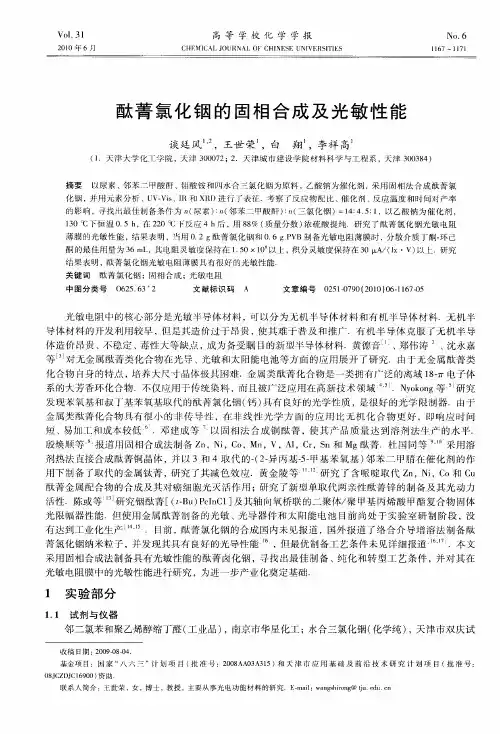

与氨基反应的荧光探针Highlights of Rhodamine and TRITC Labeling Kits:∙ Fast – label and purify antibody in about one hour∙ Amine-specific labeling – the NHS-ester or isothiocyanate efficiently labels antibodies and other purified proteins at primary amines (lysine side chains) ∙ Optimized procedure – following the standard protocol results in antibodies with excellent dye:protein ratios for optimum activity and fluorescence∙ Single-use fluors – no need to weigh tiny amounts powder; kits contain single-use vials of reagent∙Efficient purification – kits include purification resin and easy-to-use spin columns, ensuring rapid and efficient removal of non-reacted dye and excellent protein recoveryApplications for Rhodamine Labeling Reagents:∙ Label antibodies for use as immunofluorescent probes ∙ Label oligonucleotides for hybridization probes ∙Detect proteins in gels and on Western blotsProperties ofRhodamine Dyes:Thermo Scientific Pierce Rhodamine Dyes are mixtures of isomers with reactive groups attached at the 5- and 6-positions of the bottom ring. The properties of these isomers are indistinguishable in terms of excitation and emission spectra, and for protein applications there is no need to isolate a specific isomer.TRITC is the base tetramethylrhodamine molecule functionalized with an isothiocyanate reactive group (–N=C=S) at one of two hydrogen atoms on the bottom ring of the structure. This derivative is reactive towards primary amine groups on proteins, peptides and other biomolecules. NHS-Rhodamine is activated with the N -hydroxy-succinimidyl-ester (NHS ester) functional group. Compared to TRITC, the NHS-ester deriviative has greater specificity toward primary amines in the presence of other nucleophiles and results in a more stable linkage following labeling. Texas Red* Sulfonyl Chloride is a long-wavelength derivative of rhodamine that is modified with sulfonyl chloride for reaction to primary amines. We recommendDyLight594 NHS Ester as an alternative to Texas Red Sulfonyl Chloride because it is brighter, more photostable and has a more specific labeling chemistry that can be used at physiologic pH.AMCA (aminomethylcoumarin acetate) is a blue fluorescent dye whose reactive derivatives are used as contrasting probes for double and triple labeling in immunofluorescence microscopy, arrays and in situ hybridization. The desirable properties of AMCA dyes also include a relatively large Stoke's shift and resistance to photobleaching. NHS-AMCA and Sulfo-NHS-AMCA are reactive towards primary amine groups on proteins, peptides and other biomolecules, while AMCA HPDP reacts with sulfhydryls, and AMCA hydrazide is used to label glycosylation sites. AMCA Hydrazide can also be reacted with carboxyl groups using the crosslinker EDC. AMCA has an excitation maximum at 345nm and an emission maximum at 450nm.与巯基反应的荧光探针Properties of AMCA Dyes:Related Products and Resources:DyLight 405 is a newer blue fluorescent dye, tailored for various chemical and biological applications where greater photostability and fluorescence intensity, pH independence, and a narrower emission spectrum are required.DyLight 405 Antibody Labeling KitsDyLight 405 and other DyLight Reactive FluorsTech Tip #31– Calculate dye:protein (F/P) molar ratiosFluorescent Labeling– Top-level menu of all fluorescent reagents*Trademark, see link in page footer.和羰基反应的荧光探针(Carbohydrate Reactive Fluorescent Probe)。
CAS:546-68-9,钛酸四异丙酯,钛酸异丙酯,四异丙基钛酸酯,原钛酸四异丙酯,异丙氧基钛(IV) ,TPT 产品参数说明
性状:无色至淡黄色液体,在潮湿空气中发烟。
溶于多数有机溶剂,该产品极易跟-NH3、-OH、-COOH、-CONH2等到极性基团反应,特别是极易跟水发生水解,应密封避水存放。
闪点:46℃;熔点:15℃;密度(25℃)0.954;沸点(10mmhg)102~104℃
用途:生化研究。
用于有机合成中的酯交换反应和缩合反应的催化剂;在有机硅中添加,50~80℃就可固化;金属与橡胶、金属与塑料之间粘结的粘合剂;也可用于钛酸酯偶联剂、交联剂、分散剂合成
保存:RT
英文名称:TPT;Titanium(IV) isopropoxide; Titanium tetraisopropanolate
其他名称:钛酸异丙酯;四异丙基钛酸酯;原钛酸四异丙酯;异丙氧基钛(IV)
CAS号:546-68-9
Ti[OCH(CH3)2]4=284.22
级别:Biothnology grade
钛含量:16~16.8%(即大于理论值97%)
折光指数:1.4625~1.4630
异丙氧基含量(重量):≥78.80%
结晶点:≤13℃。
Agilent Prep-C18 ColumnsDatasheetGeneral DescriptionAgilent Prep-C18 utilizes an ultra-pure (Type B) silica support with high specific surface area (400 m2/gram) and 100Å pore size in two particle sizes – 5-microns and 10-microns. A proprietary bonding process gives high carbon loading (24%) and a highly inert surface. The Agilent Prep-C18 columns have high sample loadability and give symmetrical peaks even for strongly basic compounds. The columns are stable at pH 2-10. Agilent Prep-C18 is especially useful for the preparative purification of acidic, basic, and other highly polar compounds by reversed-phase liquid chro-matography. This densely covered, deactivated, col-umn packing can be especially beneficial for prepara-tive separation of basic compounds that produce poor peak shapes and lower loadability on other columns. The extra-dense coating of bonded phase and exhaus-tive endcapping simultaneously deactivate the silica surface from deleterious interactions with samples, and also protects the silica support from dissolution in in-termediate and higher pH environments. Columns are loaded to a stable, uniform bed density using a propri-etary, high-pressure slurry-loading technique to give maximum column efficiency and maintain column bed stability.Column CharacteristicsThe Agilent Prep-C18 Columns have two formats: car-tridge format for 21.2 mm ID columns and conventional fixed end-fitting formats for 30 and 50 mm ID columns. For the cartridge columns, a special fitting kit is needed to connect the columns with an instrument. The kit can be ordered from Agilent and the Agilent P/N is 820400-901. The nominal average particle size of the packings used for Agilent Prep-C18 columns is either 5-microns or 10-microns with each column length and particle size combination chosen to produce columns with high separation performance and low operating pressures. In general, in order to obtain equivalent separation on a preparative column, relative to those obtained using analytical columns of the same packing, the mobile phase flow rate must be adjusted proportional to the square of the ratio of the column internal diameters (see Table 1).All larger-diameter columns (20 mm or greater) are susceptible to cross-sectional thermal gradients where the interior core of the column becomes warmer during use compared to the area of the col-umn near the column wall. This thermal gradient, while small during room-temperature operation, can cause observable band-broadening when the column is operated under non-overload sample conditions. When operating the column using typical prepara-tive sample-overload conditions, these temperature effects are seldom important and can be ignored in most cases. The cross-sectional temperature varia-tions are caused by the frictional heating of the mobile phase as it is forced under pressure through the packed bed of the column and the small-diam-eter tubing of the instrumentation. The heat near the column walls is more easily dissipated through the heat-conductive steel walls of the column while the heat in the center of the column is insulated by the relatively non-heat-conductive silica packing material. This thermal band-broadening increases if the column is being operated at temperatures higher than ambient. To avoid thermal effects, it is recom-mended that large-diameter columns, especially the higher mass 30 and 50 mm ID x 250 mm long col-umns, be heated in a water bath at 30°C or higher, if desired. It is important to also maintain the mobile phase at the same temperature as the column to avoid thermal mis-matches which may result in dis-torted peaks.The 10µm packings used in the Agilent Prep-C18 col-umns are produced using the same particle and bond-ing technology employed in the production of 5µm Agilent Prep-C18 scalar packings in analytical size col-umns. The same thorough quality control procedures are used to monitor all Agilent Prep-C18 products, in-cluding the measurement of surface area, pore size, and particle size of the base silica packing as well as elemental analysis of all bonded phases. Sensitive chro-matographic tests are also performed on all packings to confirm lot-to-lot reproducibility. This technology permits the direct scale-up of separations from ana-lytical to preparative proportions with little or no modi-fications required in methodology.Table 1Typical Sample CapacitiesSeparation Type Column Normalized(small molecules) ID Flow Rate Easy Difficult(alpha > 1.5)(alpha=1.2-1.5) 4.6 mm 1.0 mL/min3-15mg0.5-3 mg21.2 mm20 mL/min70-400 mg20-70 mg30 mm40 mL/min140-800 mg40-140 mg50 mm100 mL/min400-2000 mg100-400 mgPrinted in USA, May 14, 2004 Part No. 820684-002 ASafety ConsiderationsThe following points with respect to the safe use of preparative columns should be considered:• Because of the larger volumes of mobile phase used with preparative columns, special awareness of sol-vent toxicity and flammability hazards is recom-mended.• Maximum operating pressure limit for Preparative Columns is 340 bar (5000psi). Since liquid chromato-graphic columns are totally hydraulic in nature, little stored energy is present in these columns during use.Should a column be over-pressurized and a tubing or fitting failure occur, the major result will be a large flow leak of mobile phase. Special caution is required in this regard for flammable or toxic solvents.Operational Guidelines•The direction of flow is marked on the column.•While generally not harmful to the column, revers-ing flow should be avoided except to attempt removal of inlet pluggage.•A new 21.2 mm ID preparative cartridge is shipped dry; therefore , flush new cartridge columns with 10column volumes of 100% organic solvent (e.g. Metha-nol or Acetonitrile) followed by at least 10 column volumes of mobile phase before use. This will avoid any equilibration problem and will ensure reproduc-ible selectivity with new columns.•New 30 and 50 mm ID columns should be flushed with at least 10 column volumes of mobile phase be-fore use.•Maximum operating pressure is 340 bar (5000 psi).•Maximum operating temperature is 60°C.•Maximum column lifetime is obtained by operation at low temperatures (< 40°C) using low buffer con-centrations in the range of 0.01 to 0.02M. Column sta-bility at pH> 6 is also enhanced by avoiding phos-phate and carbonate buffers [ref.: H.A. Claessens,M.A. van Straten, and J.J. Kirkland, J. Chromatogr.(A), 728 (1996) 259].•While the useful pH range is 2-10, caution should be taken when the columns are used at the pH limits.Extensive exposure to high or low pH mobile phase may reduce the lifetime of the columns.Preparative StrategiesA detailed discussion of how to conduct preparative liquid chromatography is beyond the scope of this data sheet. However, a few helpful guidelines can be given.•Prior to initial start-up of the preparative column or for start-up after prolonged storage (e.g., greater than 5 days), it is recommended that the column be pre-flushed with 10 column volumes of 100% organic solvent (e.g. Methanol or acetonitrile) to elute po-tential contaminants.•Use larger sample volumes of dilute solutions to avoid column overload at the inlet. However, sample vol-ume generally should not exceed one-third the vol-ume of the earliest eluting peak of interest.•Method development is best accomplished by em-ploying analytical-scale HPLC techniques. Once the optimum mobile phase/stationary phase system has been established using these approaches, the sepa-ration can be scaled up to the preparative system with only minor adjustments.•To prevent the deposition of strongly retained sample components on the preparative column, precautions such as sample filtration and pre-fractionation of the sample using gravity-feed chromatography columns,re-crystallization, distillation, etc., should be taken to maximize column life and sample throughput. Use of a guard column is highly recommended.•The interested reader is referred to the book “Pre-parative Chromatography” B.A. Bidlingmeyer, ed.,Elsevier Publishing (Volume 38 in the “Journal of Chromatography Library Science Series”) for a good compendium on strategies for successful prepara-tive separations.Storage RecommendationsLong term storage of silica-based, bonded phase col-umns should be in a pure organic solvent, preferably an aprotic liquid such as 100% acetonitrile. If the column has been previously used with a buffered mobile phase, the buffer should first be removed by purging the column with 5 to 10 column volumes of a 50/50 mixture of methanol or acetonitrile and water,followed by 2 column volumes of the pure solvent.Before storing the column, column ends should be capped with the original caps or end-plugs used for shipping the columns to prevent contamination or damage to the threaded column ends.Columns may be safely stored for short periods in most mobile phases. However, to protect equipment,it is desirable to remove salts from the instrument and column by purging the column with the same mobile phase without the buffer (e.g. using 60/40ACN/H 2O to remove a 60/40 ACN/0.02 M phosphate buffered mobile phase). Re-equilibration is rapid with the original mobile phase when using this ap-proach, and any danger of corrosion from the salts is eliminated.Agilent Ordering InformationFor more information or to order our products, visit our Agilent Technologies home page on the World Wide Web at: /chem/suppliesFor Technical Support in the US and Canada, call 1-800-227-9770 or call your local Agilent sales office.。
Nonlinear absorption properties of Ôaxial-bonding Õtype tin(IV)tetratolylporphyrin based hybrid porphyrin arraysP.Prem Kiran a ,D.Raghunath Reddy b ,Bhaskar G.Maiya b ,Aditya K.Dharmadhikari c ,G.Ravindra Kumar c ,D.Narayana Raoa,*aSchool of Physics,University of Hyderabad,Hyderabad 500046,India bSchool of Chemistry,University of Hyderabad,Hyderabad 500046,India cTata Institute of Fundamental Research,Colaba,Mumbai 400005,IndiaReceived 10September 2004;received in revised form 14March 2005;accepted 5April 2005AbstractThe nonlinear absorption properties of Ôaxial-bonding Õtype hybrid porphyrin arrays based on a tin(IV)tetra-tolylporphyrin (SnTTP)scaffold are studied with picosecond and nanosecond pulses.The effect of different central metal atoms substituted adjacent to the tin(IV)porphyrin in the oligomer structure is discussed.In the picosecond regime the lifetimes of the excited singlet states and two-photon absorption (TPA)processes dominate leading to inter-esting switching of nonlinear absorption behaviour.The TPA cross-section (r TPA )is found to be as high as 396·10À46cm 4s photon À1molecule À1,for an oligomer with Sn and Ni porphyrin macrocycles.However,in the nano-second regime the optical limiting performance has increased considerably with increasing number of porphyrins in the array and excited state absorption is found to play a major role.Ó2005Elsevier B.V.All rights reserved.PACS:42.65.Àk;42.65.Re;42.79.ÀeKeywords:Nonlinear optics;Ultrafast processes;Optical limiting1.IntroductionNonlinear absorption is a phenomenon defined as an increase or decrease in the absorption coeffi-cient with increasing intensity.The former re-sponse is called as reverse saturation of absorption (RSA),while the latter is known as sat-uration of absorption (SA).Organic materials with delocalized electrons are of great importance be-cause of their large nonlinear optical absorption coefficients,architectural flexibility,and ease of0030-4018/$-see front matter Ó2005Elsevier B.V.All rights reserved.doi:10.1016/j.optcom.2005.04.008*Corresponding author.Tel./fax:+9104023011230.E-mail address:dnrsp@uohyd.ernet.in (D.N.Rao).Optics Communications 252(2005)150–161fabrication.Recently materials showing RSA behaviour have been in focus for optical limiting applications[1].SA in various materials has been studied for applications in laser pulse compression and laser amplification[2,3].An intense laser pulse redistributes the molecular population between the ground and excited states causing a transient mod-ification in the optical properties of the material. The dependence of transmission of organic mole-cules on light intensity can yield considerable information on the molecular level system that can lead to variety of nonlinear optical processes like limiting,switching and bistability.Metallo-porphyrins and metallophthalocyanines form an important class of electronic materials because of the large p-electron conjugation over two-dimen-sional molecular structure[4,5].Interest in ad-vanced electronic and photonic materials recently has led to the exploration of conjugated polymers of more complex units,such as porphyrins[6].The high polarizability and optical oscillator strength of the porphyrin macrocycles gives these materials remarkable nonlinear optical(NLO)behaviour, making them potentially useful for ultrafast switching technologies.High values of the nonlin-ear refractive index n2(which is proportional to the real part of the third order susceptibility v(3)) are essential for electro-optical and all-optical switching[6],whereas high nonlinear absorption coefficients,b(proportional to the imaginary part of v(3))are important for optical limiting[7].The architecture of the porphyrin macrocycles is important for developing materials with optimum nonlinearity and response times[8].Structural modifications to the porphyrin ring can be ex-pected to yield molecules with diverse photophys-ical and photochemical properties that will in turn affect their optical nonlinearity.This would lead to an increase in a variety of excited state pro-cesses including enhanced internal conversion and intersystem crossing(ISC),ion-association,excita-tion energy transfer,photoinduced electron trans-fer,etc.[9].Such effects can be conveniently harnessed to enhance the third order nonlinearity and nonlinear absorption properties,hence to de-velop promising materials for various applications. Excited state absorption(ESA)is the most impor-tant mechanism leading to optical limiting in por-phyrins[10–12].Our group has been involved in studies on a class of porphyrins,known as tetratol-ylporphyrins,for achieving higher optical limiting performance and nonlinear absorption.The tetra-tolylporphyrins synthesized have higher third or-der nonlinearities[10,11,13]and efforts are being made to attain large excited state absorption cross-sections through structural modifications. In this paper,we discuss the nonlinear absorption properties of oligomers based on Sn(IV)TTP scaf-fold that lead to an interesting nonlinear switching behaviour.2.Molecular structure and linear optical propertiesThe nomenclature of monomer and dimer molecule is meso-5,10,15,20-(tetratolyl)porphy-rinato tin(IV)dihydroxide;[(TTP)Sn IV(OH)2] and[l-[5,10,15-tri(p-tolyl)-20-[4-[2-[4-[10,15,20-tri(p-tolyl)-5-porphyrinyl]phenoxy]ethoxy]phenyl] porphyrinato]]di(tin)(IV)tetrahydroxide;[(TriTP)–Sn IV(OH)2]–O(CH2)2O–[(TriTP)Sn IV(OH)2],res-pectively.Dimer molecule has two monomers linked at meso position with ethoxy spacer.Mono-mer and dimer are synthesized following the procedure reported in the literature[14,15].For simplicity we mention them as SnTTP and Sn–Sn(TTP)2in this paper.Sn IV porphyrin based,Ôaxial-bondingÕtype hybrid trimers and hexamers are constructed by employingÔbuilding-blockÕap-proach.The approach involves simple inorganic reactions such as axial bond formation of main group element containing porphyrins and inser-tion of metal/metalloid ions into the porphyrin cavity.The architecture of the trimer arrays[16] is such that Sn IV complex of meso-5,10,15,20-(tet-ratolyl)porphyrin forms the basal scaffolding unit, the free-base,Ni II porphyrins occupy the two axial sites via an aryloxy bridge.The nomenclature of the porphyrin trimer arrays discussed here is as follows:(free-base porphyrin)2(tin(IV)porphy-rin)”[(TTP)–Sn IV(H2TriTP(O))2]and(nickel(II) porphyrin)2(tin(IV)porphyrin)”[(TTP)–Sn IV(Ni-TriTP(O))2].For simplicity these trimers are re-ferred as Sn–(H2)2(TTP)3and Sn–Ni2(TTP)3, respectively.The scheme of construction ofP.P.Kiran et al./Optics Communications252(2005)150–161151hexamer arrays employs a synthetic protocol involv-ing sequentialÔorganicÕandÔinorganicÕreactions con-ducted,respectively,at the peripheral meso-phenyl ring and the central Sn IV ion of the porphyrin scaf-fold.The architecture of hexamers[15]are based on a covalently linked Sn IV porphyrin dimer,with each of the two Sn IV porphyrins centers trans-axi-ally ligated to two free-base,zinc(II)porphyrins. The nomenclature of the hexamers is given as follows:[(TTP)–Sn IV(H2TriTP(O))2]–O(CH2)2O–[(TTP)–Sn IV(H2TriTP(O))2]and[(TTP)–Sn IV (ZnTriTP(O))2]–O(CH2)2O–[(TTP)–Sn IV(ZnTriT-P(O))2].These arrays are referred as Sn2–(H2)4(TTP)6and Sn2–Zn4(TTP)6arrays.The molecular structure and UV–VIS absorption prop-erties of the trimers and hexamers are reported elsewhere[15,16].A comparison of the UV–VIS spectrum of a gi-ven trimer and hexamer with the spectra of the cor-responding monomeric porphyrin suggested that the absorption peaks of these array are in the same range as those of the reference compounds.In addi-tion,the molar absorptivities at the peak maxima (e)values of the bands due to trimers and hexamers are nearly equal to the sum of those due to their constituent monomers.Minor variations in the spectral features of the trimers with respect to the corresponding monomers are ascribed to theÔsub-stituent effectsÕ,i.e.,differences in the axial ligands of Sn IV porphyrins and the meso substituents of the free-base porphyrins/metalloporphyrins.These indicate that there is minimal perturbation of the electronic structures of the individual macrocyclic p-systems in these arrays.Specifically there exists no indication of the presence of exciton coupling between the porphyrin rings,i.e.,basal–basal,ba-sal–axial,or axial–axial interaction in these arrays. On the other hand,the singlet state activities of these oligomers are quite different from those of the precursor reference compounds as probed by steady-statefluorescence.In the case of trimers,fluorescence due to both the basal and axial porphyrins is considerably quenched in comparison with that due to the monomeric chromophores.Whereas,the spectral shapes and the wavelengths of maximum emission for the individual chromophores of these arrays re-mains close to those due to the corresponding monomeric entities.Thus,the singlet state energy values(E0–0values of H2,Zn II and Sn IV porphy-rins are1.94,2.07,and2.04eV,respectively)of the individual components of these arrays are as-sumed to be essentially similar to those of their constituent monomers.In the case of hexamers, strong quenching offluorescence is observed.The percent quenching is close to100,with the band that is characteristic of Sn IV porphyrin emission being totally absent in the spectra.This is in con-trast with the partial quenching observed in case of trimers.In trimer molecules,photoinduced elec-tron transfer(PET)occurs from the axial porphy-rin to the basal Sn IV porphyrin and excitation energy transfer(EET)occurs from basal Sn IV por-phyrin to axial acceptors.In the case of hexamers, in addition to the EET from the basal Sn IV por-phyrin to its own two axial free-base acceptors, additional energy transfer from a given Sn IV por-phyrin to the free bases ligated at the neighbouring Sn IV centers,i.e.,Ôtrans-axialÕenergy transfer is likely to occur leading to more efficient quenching.A very high efficiency of energy transfer from the basal Sn IV porphyrin to the axial acceptors is ob-served in these axial-bonding type donor–acceptor hexamers[15]and less prominent PET reaction from axial acceptor to basal Sn IV porphyrin can rationalize the100%quenching observed for the fluorescence due to tin(IV)porphyrins of these hexameric assemblies.A generalized energy level diagram illustrating the singlet state dynamics and charge transfer(CT)states pertaining to the photoactive arrays of trimer and hexamer are re-ported earlier[15].The effect of PET,EET and the CT states formed in these oligomers are found to vary the singlet state properties and these effects were considered while estimating thefigures of merit for nonlinear absorption.Fluorescence lifetimes and the respectivefluo-rescence yields of these porphyrin molecules stud-ied in dichloromethane as solvent are given in Table1.Fluorescence lifetimes are measured using time correlated single photon counting(TCSPC) technique explained in the next section.All these molecules have bi-exponential decays for s S1repre-senting fast and slow decay.For SnTTP the life-time is0.562;1ns.In the case of trimers,s S1has increased to0.74and5.93ns in Sn–(H2)2(TTP)3152P.P.Kiran et al./Optics Communications252(2005)150–161trimer and with metal substitution in case of Sn–Ni2(TTP)3s S1is$0.62and2.13ns.As the arrayis becoming larger,the contribution of slowly decaying(long lived)component has increased. In case of Sn2–(H2)4(TTP)6,S1has a tri-exponen-tial decay with0.454,1.95and7.25ns whereas for Sn2–Zn4(TTP)6it is a bi-exponential decay of 0.667and1.73ns.The lifetimes of thefirst excited singlet state have varied considerably with the me-tal substitution in hexamers.Substitution of Zn as central metal atom in porphyrin ring is reported to vary the singlet state properties and triplet state formation quite significantly[17].As the excitation pulse is6ns,the longer S1lifetime of Sn2–(H2)4(TTP)6will help in enhanced ESA and ISC, which lead to better optical limiting performance. Fluorescence decay curves for tin monomer,tri-mer,hexamer having Sn and H2as two centers are shown in Fig.1(a).Fig1(b)shows the varia-tion in thefluorescence lifetimes with the substitu-tion of Zn in the hexamer array.PET and EET are found to be responsible for the observed variation in the singlet state properties.PET from ground-state free-base porphyrin to the singlet-state Sn IV porphyrin leads to a charge transfer state of Sn IV PÀ–H2P+and involves free-energy changes leading to formation of charge transfer states. These charge transfer states lead to delocalization of singlet states and thefluorescence emission wavelength is red shifted quite considerably.3.Experimental detailsFluorescence lifetime of thefluorphores is mea-sured using various methods.Among all,time cor-related single photon counting(TCSPC)is rated as the best method.TCSPC is a digital technique, which counts the photons that are time correlated with the excitation pulse.The heart of the method is a time-to-amplitude converter.A mode locked Tsunami picosecond laser second harmonic (405nm,FWHM$1.2ps)operated at4MHz is used as the excitation source.The decay measure-ments are done using afluorescence lifetime spec-trometer(Model5000U,IBH,UK).The excitation beam is focused onto the sample and fluorescence is collected at right angles to the exci-tation beam and is detected by a MCP-PMT (Hamamatsu R3809U)after passing through a monochromator.Signal from the PMT is fed to the discriminator and the output of the discrimina-tor is used as a stop signal for TAC(time to ampli-tude converter).The start signal is derived from the high-speed silicon detector(Thor Labs Inc., DET210).The photodiode signal is converted to TTL by pulse converter(IBH,Model TB-01)and the output is used as a start pulse for TAC.The TAC output is fed to the MCA card(Oxford Corp.,UK).Repetitive laser pulsing and emittedTable1Fluorescence lifetimes and%yields of Sn(IV)TTP oligomersPorphyrin s S1[ns],(%fluorescence yield)SnTTP0.562(71),1(28)Sn–Sn(TTP)20.57(95),4.94(5)Sn–(H2)2(TTP)30.744(71),5.93(28)Sn–Ni2(TTP)30.62(70),2.13(29)Sn2–(H2)4(TTP)60.454(28),1.95(23),7.25(47)Sn2–Zn4(TTP)60.667(30),1.73(69)P.P.Kiran et al./Optics Communications252(2005)150–161153photon collection produced a histogram of time versus counts,representing thefluorescence decay. The data analysis is carried out using the software provided by IBH(DAS-6)that is based on recon-volution technique incorporating iterative nonlin-ear least square methods.Frequency doubled Nd:YAG lasers with25ps and6ns pulse widths,10Hz repetition rate are used for the nonlinear absorption experiments. The porphyrin solutions in chloroform are used for the experimental studies.Open aperture Z-scan [18]studies are carried out by focusing the input beam on to the sample with linear transmission of approximately75%at532nm using lenses of 500mm and of125mm focal length to60and 30l m spot size at focus in case of25ps and6ns pulses,respectively,and the transmitted light is col-lected with a fast photodiode.The peakfluences used in the Z-scan experiments with25ps pulses are approximately in the range of5–52GW cmÀ2. The standard f/5geometry is used for the optical limiting studies[19].The linear transmission of the porphyrin solutions is approximately70–75% for1-mm path length of the sample at the excita-tion wavelength.The inputfluence is varied in the range of30l J cmÀ2to70J cmÀ2in the nanosec-ond regime.The optical limiting and Z-scan studies are performed at the concentration of$10À4M ensuring identical concentration conditions for both picosecond and nanosecond regimes.4.Nonlinear absorption propertiesThe nonlinear absorption behaviour observed in these hybrid arrays is totally different at nano-second and picosecond timescales.In the picosec-ond regime the behaviour switches from RSA to SA and then again to RSA as the intensity in-creases.However,in the nanosecond regime all these molecules show good RSA in the intensity range studied.No switching from RSA to SA is observed with the nanosecond excitation.4.1.Excitation by25ps pulsesAt lower intensities for picosecond pulses these materials show only RSA.With increasing inten-sity an interesting changeover from RSA to SA and then back to RSA is observed.SnTTP mono-mer shows a regular RSA behaviour at lower con-centrations(corresponding to75–80%linear transmission at532nm)and at lower intensities. At higher intensities the ESA saturates and SA fol-lowed by RSA is observed as shown in Fig.2(a). As the intensity is further increased to $38GW cmÀ2,the nonlinear absorption shows a sudden transition to RSA at higher intensities within SA behaviour(Fig.2(b)).In the case of di-mer,at lower intensities only RSA is observed (Fig.3(a)),and as the intensity increases,the switching of the nonlinear absorption from RSA to SA and then back to RSA is observed(Fig. 3(b)).As the intensity increases the SA behaviour after RSA goes down and the RSA behaviour be-comes more dominant.154P.P.Kiran et al./Optics Communications252(2005)150–161In the case of oligomers with Sn(IV)TTP sur-rounded by free-base porphyrin(H2TTP),at lower concentrations and at lower intensities RSA is ob-served and with increasing intensity saturation of the ESA is observed.The saturation has increased with increasing input intensity.The open aperture Z-scan curves for Sn–(H2)2(TTP)3are shown in Fig.4.Sn2–(H2)4(TTP)6also shows similar behav-iour and at higher intensities the saturation has in-creased quite considerably.While replacing H2TTP in axial position with NiTTP lead to a to-tal reversal in the nonlinear absorption behaviour. For Sn–Ni2(TTP)3,at lower concentrations,at lower input intensities saturation of absorption alone is observed.With gradual increase in the in-put intensity RSA followed by initial SA is ob-served(Fig.5(a))and at higher intensities pure RSA was observed(Fig.5(b)).As the intensity is increased the RSA started to take over and at higher intensities RSA completely dominates due to TPA assisted ESA.At higher concentrations (60%linear transmission at532nm)the behaviour remained pure RSA as shown in Fig.5(b).For Sn–Ni2(TTP)3with532nm excitation falling in the edge of the absorption band,the lowest of the S1 energy levels get excited and therefore one expects more localization of the energy leading to SA at lower intensities,whereas,at higher intensities TPA dominates and assisted by ESA shows pure RSA.However,for Sn2–Zn4(TTP)6at lower con-centrations,a transition from SA to RSA due to two-photon/multi-photon absorption is observed. The open aperture Z-scan curve looks similar to that shown in Fig.5(a)and with increasing inten-sity we observe more contribution from RSA. At higher concentrations and the intensity ofP.P.Kiran et al./Optics Communications252(2005)150–16115528.5GW cmÀ2,saturation of absorption due to ex-cited states is observed(similar to Fig.4(a))with transmittance at focus going up to0.84and the curves appear slightly broader indicating the con-tribution of ESA.As the intensity has increased to$52GW cmÀ2,RSA is observed after satura-tion of absorption due to TPA(similar to that shown in Fig.2(b)).From the open aperture Z-scan curves given in Fig.2–5,it is very clear that under the similar experimental conditions,the nonlinear absorption response of these molecules is very different from that of each other,clearly indicating the effect of the presence of different central metal atoms in the porphyrin oligomer structures.Further if the nonlinear absorption is due to the solvent at higher intensity due tofifth order or higher order processes,we will not ob-serve the saturation behaviour in the curves at the focal point(Fig.4).This is an indirect confir-mation that the observed behaviour is due to the saturation of the higher excited states of the por-phyrins molecule.In order to confirm that the nonlinear absorption at higher intensities are due to the porphyrins and not due to the solvent,we carried out the Z-scan studies in pure solvent at intensity ranges of10–52GW cmÀ2.The observed RSA behaviour at the focal point is negligible compared to the signals seen with the porphyrins solution(2%variation compared to50%variation in porphyrins)and the effect of the solvent has been accounted for in all calculations.Though the ESA,TPA and the lifetimes of the higher ex-cited states appears to play an important role in the nonlinear absorption of all these oligomers, TPA is more dominant in oligomers having me-tal–metal porphyrin macrocycles(Sn–Ni,Sn–Sn, Sn–Zn)and is absent in molecules having metal–free-base porphyrin interaction.Observations of RSA at lower intensities and then SA due to saturation of ESA with picosecond pulse excitation has been reported earlier in cad-mium texaphyrin[20]and in HITCI[21,22]. Depending on the input pulse duration,nonlinear absorption in these materials normally occurs through transitions from S0!S n states by instan-taneous TPA or from S0!S1!S n states by a two-step resonant ESA(if S1!S n occurs after vibrational transitions or diffusion within the sin-glet states)or T1!T n states by means of ESA. From the equilibrium level S1the molecules may relax radiatively or nonradiatively to the ground state or transfer to the lower level of triplet mani-fold,T1.Efficient RSA for picosecond pulses re-quires that the recovery rate from the S1state be slow compared to the optical pumping rate.In-tra-band vibrational relaxation times also play an important role for RSA.The higher excited states of the singlet manifold relax to the lower vibra-tional states,leading to absorption of the pump from the lower singlet sublevels to the higher ex-cited states through ESA.In metalloporphyrins, N and L bands exist at higher energies(317nm) in addition to the low energy B and Q bands. The N and L bands are more prominent in SnTTP compared to NiTTP and ZnTTP,whereas in156P.P.Kiran et al./Optics Communications252(2005)150–161H2TTP,N and L bands are not prominent.At higher excitation intensities,the possibility of reso-nant two-photon transition to the N,L bands from the lower singlet states increases.At the intensities and the pulse width used one need to consider the effect of multi-photon absorption (MPA)also.Although MPA in some of the aro-matic hydrocarbons like benzene and toluene is predicted and later observed experimentally lead-ing to nonlinear absorption,we have not observed any significant nonlinear absorption in the chloro-form solvent used.Two-photon and three-photon processes leading to optical limiting are well re-ported in various organic compounds[23].For porphyrins the intersystem crossing time(s ISC), which is of the order of few nanoseconds in general and few hundreds of picoseconds in some specific cases,is of minor consequence because of the 25ps pulse width of the laser.For the picosecond excitation we therefore can neglect intersystem crossing and hence the contribution of the T1state, which makes the singlet states responsible for the observed behaviour at these time scales.The values of excited state parameters r ex/r0, TPA coefficient(b in cm GWÀ1),TPA cross-sec-tion(r TPA)and s sn are estimated using a general-izedfive-level model and from the rate equations. The generalizedfive-level model effectively be-comes a three-level model for picosecond pulse excitation as the contribution from the triplets can be neglected,since the intersystem crossing from singlet to triplet state is very less.The differ-ential equations arefirst de-coupled and then inte-grated over time,length,and along the radial direction,and then are solved numerically using Runge–Kutta fourth order method.Assuming the input beam to be a Gaussian,the limits of inte-gration for r,t,and z are varied from0to1,À1 to1,and0to L(length of the sample),respec-tively.Typical number of slices used for r,t,and z are60,30,and5,respectively.r1,r ex,b and s ISC are then estimated through least squarefit of the experimental data[24].The lifetime of the higher excited singlet state S n(s Sn)has been evaluated and the lifetimes of thefirst excited singlet state is taken as given in Table1.Table2gives the absorption cross-section and lifetime of the excited states and the TPA coefficient(b)and cross-section (r TPA).The TPA cross-section is calculated using the relation[25]b¼N0r TPA;where h is the PlanckÕs constant,m is the frequency of light,and N0is the number molecules per unit volume.From the Table2it is clear that the TPA cross-section is large and comparable with the values of 11,000GM(1GM=10À50cm4s photonÀ1mole-culeÀ1)reported with dendrimer molecules com-prising29repeat units[26].The most plausible explanation for such a large TPA cross-section in our case is due to the fact that PET,EET and Ôtrans-axialÕenergy transfer processes occurring simultaneously in the same porphyrin oligomeric structure leading to more delocalization of the sin-glet states thereby causing considerable changes in the absorption from the S1to the S n states,which follows the square law for intensity dependence, leading to enhanced TPA.Such a delocalization can further enhance TPA assisted by ESA from the singlet states.Such drastic enhancement of TPA in porphyrins has been reported due to the resonant absorption and with the substitution of electron accepting groups[27,28].Out of the differ-ent oligomers studied,the trimer having Sn,Ni porphyrins linked axially has very high r TPA.This could be due to the fact that the excitation wave-length is in resonance with the S0–S1transition thus increasing the possibility of ESA assisting TPA.The lifetimes of the excited singlet states(s Sn) are evaluated using theoreticalfits(Table2).All these oligomers are found to have the excited states relaxing in few picoseconds to few hundreds of picosecond and compare well with the reports in the literature.Sn–H arrays show longer Table2Excited state parameters r1/r0,s sn and TPA coefficient b with 25ps pulse excitationPorphyrin(r1/r0)s Sn(ps)b(cm GWÀ1)r TPA a(10À46cm4s) SnTTP18.32600.45 2.7Sn–Sn(TTP)2 3.007.5 1.5013.6Sn–(H2)2(TTP)3 3.13500––Sn–Ni2(TTP)335.7050 1.45396.0Sn2–(H2)4(TTP)6 1.93500––Sn2–Zn4(TTP)6 2.39150.9015.7a The error in the rTPAis10%.P.P.Kiran et al./Optics Communications252(2005)150–161157s Sn$500ps whereas rest of the molecules shows faster s Sn.Ultrafast relaxations of the order of few hundred femtoseconds are well known in por-phyrin-acceptor systems due to electron transfer [29].Photoinduced charge separation,thermal charge recombination electron transfer due to por-phyrin localized charge transfer character in a di-rectly linked pyromellitimide-(porphyrinato) Zn(II)complex and similar donor–acceptor sys-tems are reported to be in the timescales of770 and5200fs[30].Competition between internal conversion and energy transfer in the upper ex-cited singlet state of the porphyrin-ruthenium complexes are also reported[31].Lammi et al.[32]reported energy and charge transfer between the adjacent states leading to excited state quench-ing at timescales611ps and between different sites by super exchange assisted energy transfer at time-scales of655ps in diphenyl ethyne linked porphy-rin dyads and triads and the relaxation rates can be tuned using the porphyrin-linker connection motif.Ultrafast excitation energy transfer pro-cesses are observed to be in the order of 12±3ps in Zn(II)porphyrin box[33].Increasing number of porphyrin units has also reported to accelerate the relaxation dynamics of the lowest excited states from4.5ps for dimer to0.3ps for hexamer[34].OÕKeefe et al.[35]reported a two-component decay,of approximately700fs and 170±50ps due to exciton–exciton annihilation and exciton diffusion to recombination centers on the polymer chain from femtosecond transient photoinduced transmission measurements on Zinc conjugated porphyrin polymer.Similar faster de-cay of13±5ps is also reported for dimer[35] due to the rotational diffusion of the excited mole-cule in solution.Relaxations of$6ps are also re-ported in ethylene bridged side-to-side OEP porphyrin dimer[36].Excited-state energy transfer is reported to be operative at timescales of3.5and 10ps in p-phenylene linked porphyrin dimers[37], which varies with the bridge linker.Ultrafast kinetics of a hexameric benzo-porphyrin com-pound investigated by femtosecond transient absorption spectroscopy,shows that in the hexa-mer a20ps decay component is present which is attributed to an intramolecular interchromophoric excited-state process[38].In cofacial lanthanide porphyrin macrocycles two relaxation processes with time constants of$1.5and10ps are reported [39].Energy transfer to the nearest porphyrin in chelate assembly separated by approximately15–18.5A˚is reported to occur in$10ps,which varies with the separation[40].4.2.Excitation by6ns pulsesWith6ns pulse excitation the nonlinear absorp-tion behaviour is completely different compared to that observed with25ps pulses.OL curves for monomer SnTTP,trimer Sn2–(H2)2(TTP)3and hexamer Sn2–(H2)4(TTP)6at$75%linear trans-mission at532nm shown in Fig.6clearly indicates the enhanced limiting behaviour as one moves to higher homologues.Fig.7(a)and(b)shows the variation in the limiting curves for SnTTP and Sn–Sn(TTP)2at different linear transmissions of 85%and70%.With the introduction of heavier metalloporphyrin in the axial position in place of free-base porphyrin,in trimer and hexamer do-nor–acceptor homologues,lead to slightly reduced limiting response.OL curves for hexamers with free-base and Zn porphyrins in axial position are shown in Fig.8.Though the limiting threshold has not varied greatly,the onset of limiting varies certainly,with lower values for the oligomers. Throughputfluences from these hybrids are as158P.P.Kiran et al./Optics Communications252(2005)150–161。